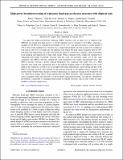High power breakdown testing of a photonic band-gap accelerator structure with elliptical rods
Author(s)
Munroe, Brian James; Cook, Alan M.; Shapiro, Michael; Temkin, Richard J.; Dolgashev, Valery A.; Laurent, Lisa L.; Lewandowski, James R.; Yeremian, A. Dian; Tantawi, Sami G.; Marsh, Roark A.; ... Show more Show less
DownloadMunroe-2013-High power breakdown testing of a photonic band-gap accelerator structure with elliptical rods.pdf (1.942Mb)
PUBLISHER_CC
Publisher with Creative Commons License
Creative Commons Attribution
Terms of use
Metadata
Show full item recordAbstract
An improved single-cell photonic band-gap (PBG) structure with an inner row of elliptical rods (PBG-E) was tested with high power at a 60 Hz repetition rate at X-band (11.424 GHz), achieving a gradient of 128 MV/m at a breakdown probability of 3.6×10-3 per pulse per meter at a pulse length of 150 ns. The tested standing-wave structure was a single high-gradient cell with an inner row of elliptical rods and an outer row of round rods; the elliptical rods reduce the peak surface magnetic field by 20% and reduce the temperature rise of the rods during the pulse by several tens of degrees, while maintaining good damping and suppression of high order modes. When compared with a single-cell standing-wave undamped disk-loaded waveguide structure with the same iris geometry under test at the same conditions, the PBG-E structure yielded the same breakdown rate within measurement error. The PBG-E structure showed a greatly reduced breakdown rate compared with earlier tests of a PBG structure with round rods, presumably due to the reduced magnetic fields at the elliptical rods vs the fields at the round rods, as well as use of an improved testing methodology. A post-testing autopsy of the PBG-E structure showed some damage on the surfaces exposed to the highest surface magnetic and electric fields. Despite these changes in surface appearance, no significant change in the breakdown rate was observed in testing. These results demonstrate that PBG structures, when designed with reduced surface magnetic fields and operated to avoid extremely high pulsed heating, can operate at breakdown probabilities comparable to undamped disk-loaded waveguide structures and are thus viable for high-gradient accelerator applications.
Date issued
2013-01Department
Massachusetts Institute of Technology. Department of Physics; Massachusetts Institute of Technology. Plasma Science and Fusion CenterJournal
Physical Review Special Topics - Accelerators and Beams
Publisher
American Physical Society
Citation
Munroe, Brian J. et al. “High Power Breakdown Testing of a Photonic Band-gap Accelerator Structure with Elliptical Rods.” Physical Review Special Topics - Accelerators and Beams 16.1 (2013).
Version: Final published version
ISSN
1098-4402